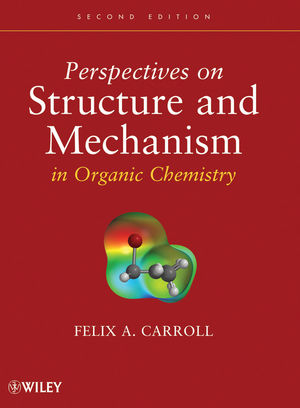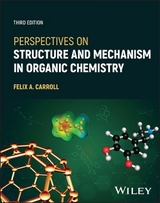
Perspectives on Structure and Mechanism in Organic Chemistry
John Wiley & Sons Inc (Verlag)
978-0-470-27610-5 (ISBN)
- Titel erscheint in neuer Auflage
- Artikel merken
Helps to develop new perspectives and a deeper understanding of organic chemistry Instructors and students alike have praised Perspectives on Structure and Mechanism in Organic Chemistry because it motivates readers to think about organic chemistry in new and exciting ways. Based on the author's first hand classroom experience, the text uses complementary conceptual models to give new perspectives on the structures and reactions of organic compounds.
The first five chapters of the text discuss the structure and bonding of stable molecules and reactive intermediates. These are followed by a chapter exploring the methods that organic chemists use to study reaction mechanisms. The remaining chapters examine different types of acid-base, substitution, addition, elimination, pericyclic, and photochemical reactions.
This Second Edition has been thoroughly updated and revised to reflect the latest findings in physical organic chemistry. Moreover, this edition features:
New references to the latest primary and review literature
More study questions to help readers better understand and apply new concepts in organic chemistry
Coverage of new topics, including density functional theory, quantum theory of atoms in molecules, Marcus theory, molecular simulations, effect of solvent on organic reactions, asymmetric induction in nucleophilic additions to carbonyl compounds, and dynamic effects on reaction pathways
The nearly 400 problems in the text do more than allow students to test their understanding of the concepts presented in each chapter. They also encourage readers to actively review and evaluate the chemical literature and to develop and defend their own ideas.
With its emphasis on complementary models and independent problem-solving, this text is ideal for upper-level undergraduate and graduate courses in organic chemistry.
FELIX A. CARROLL, PhD, is the Joseph R. Morton Professor of Chemistry at Davidson College. His research focuses on organic photochemistry and photophysics, kinetics, the synthesis and characterization of insect pheromone analogues, the correlation of molecular structure with physical properties, and the combustion characteristics of organic compounds. Dr. Carroll has published extensively in the peer-reviewed literature and was awarded a patent in the field of insect pheromones.
Preface xi Acknowledgments xiii
Introduction xv
Chapter 1 Fundamental Concepts of Organic Chemistry 1
1.1 Atoms and Molecules 1
1.2 Heats of Formation and Reaction 8
1.3 Bonding Models 19
1.4 Complementary Descriptions of the Double Bond 42
1.5 Choosing Models in Organic Chemistry 48
Chapter 2 Stereochemistry 53
2.1 Introduction 53
2.2 Stereoisomerism 56
2.3 Manifestations of Stereoisomerism 86
2.4 Stereotopicity 94
Chapter 3 Conformational Analysis and Molecular Mechanics 113
3.1 Molecular Conformation 113
3.2 Conformational Analysis 119
3.3 Molecular Mechanics 135
3.4 Molecular Strain and Limits to Molecular Stability 155
Chapter 4 Applications of Molecular Orbital Theory and Valence Bond Theory 175
4.1 Introduction to Molecular Orbital Theory 175
4.2 Aromaticity 199
4.3 Contemporary Computational Methods 220
4.4 Valence Bond Theory 237
Chapter 5 Reactive Intermediates 253
5.1 Reaction Coordinate Diagrams 253
5.2 Radicals 256
5.3 Carbenes 278
5.4 Carbocations 289
5.5 Carbanions 310
5.6 Choosing Models of Reactive Intermediates 320
Chapter 6 Methods of Studying Organic Reactions 327
6.1 Molecular Change and Reaction Mechanisms 327
6.2 Methods to Determine Reaction Mechanisms 327
6.3 Applications of Kinetics in Studying Reaction Mechanisms 341
6.4 Arrhenius Theory and Transition-State Theory 348
6.5 Reaction Barriers and Potential Energy Surfaces 360
6.6 Kinetic Isotope Effects 370
6.7 Substituent Effects 385
6.8 Linear Free Energy Relationships 389
Chapter 7 Acid and Base Catalysis of Organic Reactions 413
7.1 Acidity and Basicity of Organic Compounds 413
7.2 Acid and Base Catalysis of Chemical Reactions 433
7.3 Acid and Base Catalysis of Reactions of Carbonyl Compounds and Carboxylic Acid Derivatives 439
Chapter 8 Substitution Reactions 469
8.1 Introduction 469
8.2 Nucleophilic Aliphatic Substitution 472
8.3 Electrophilic Aromatic Substitution 518
8.4 Nucleophilic Aromatic and Vinylic Substitution 527
Chapter 9 Addition Reactions 551
9.1 Introduction 551
9.2 Addition of Halogens to Alkenes 553
9.3 Other Addition Reactions 585
Chapter 10 Elimination Reactions 633
10.1 Introduction 633
10.2 Dehydrohalogenation and Related 1,2-Elimination Reactions 638
10.3 Other 1,2-Elimination Reactions 665
Chapter 11 Pericyclic Reactions 697
11.1 Introduction 697
11.2 Electrocyclic Transformations 702
11.3 Sigmatropic Reactions 715
11.4 Cycloaddition Reactions 731
11.5 Other Concerted Reactions 747
11.6 A General Selection Rule for Pericyclic Reactions 753
11.7 Alternative Conceptual Models for Concerted Reactions 756
Chapter 12 Photochemistry 787
12.1 Photophysical Processes 787
12.2 Fundamentals of Photochemical Kinetics 804
12.3 Physical Properties of Excited States 810
12.4 Representative Photochemical Reactions 818
12.5 Some Applications of Organic Photochemistry 853
Problems 862
References for Selected Problems 871
Permissions 883
Author Index 895
Subject Index 927
| Erscheint lt. Verlag | 17.9.2010 |
|---|---|
| Zusatzinfo | Photos: 100 B&W, 0 Color; Drawings: 500 B&W, 0 Color; Tables: 25 B&W, 0 Color |
| Verlagsort | New York |
| Sprache | englisch |
| Maße | 10 x 10 mm |
| Gewicht | 2472 g |
| Themenwelt | Naturwissenschaften ► Chemie ► Organische Chemie |
| ISBN-10 | 0-470-27610-X / 047027610X |
| ISBN-13 | 978-0-470-27610-5 / 9780470276105 |
| Zustand | Neuware |
| Informationen gemäß Produktsicherheitsverordnung (GPSR) | |
| Haben Sie eine Frage zum Produkt? |
aus dem Bereich



